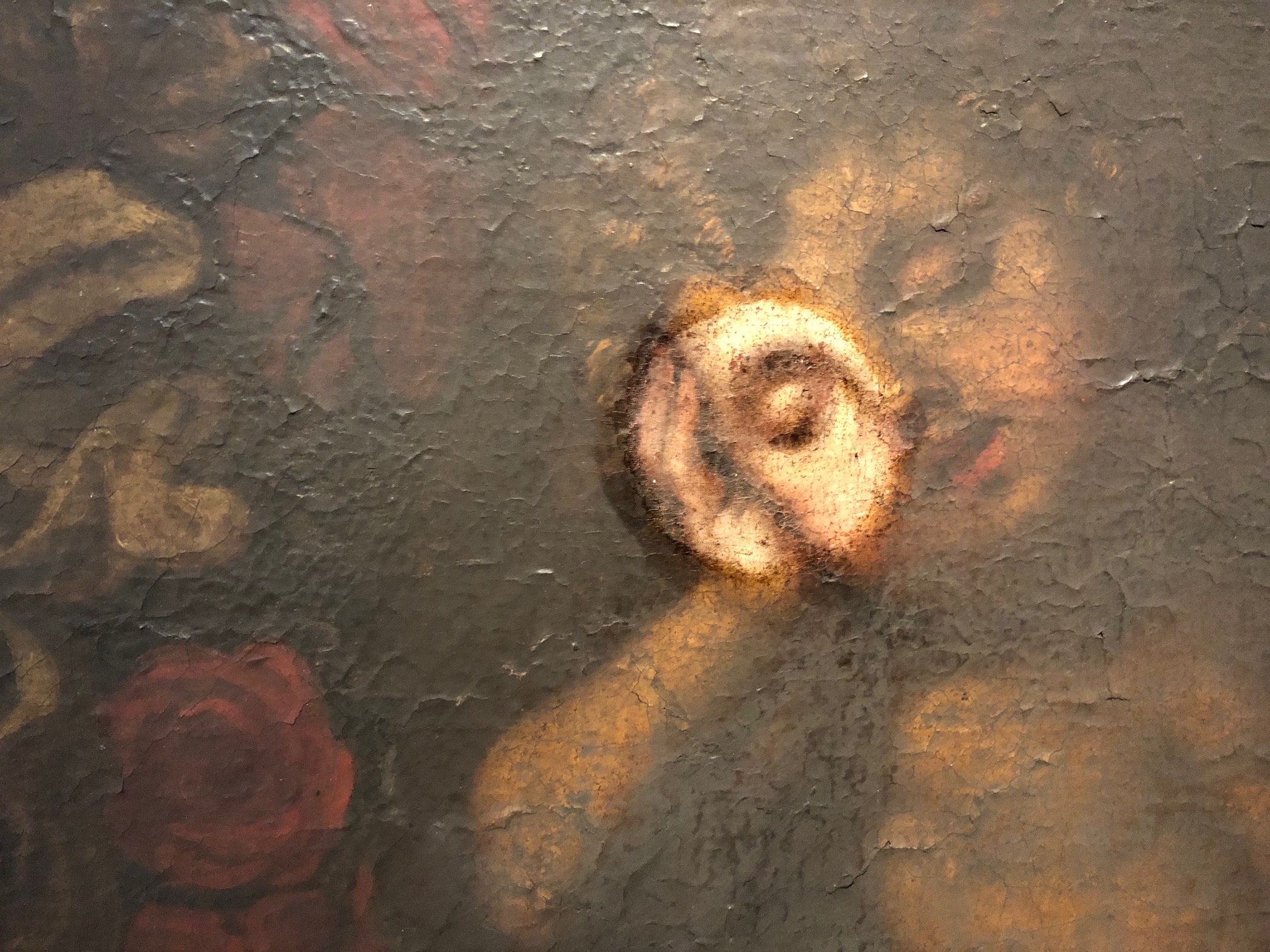
At the centre of ‘The curious moaning of Kenfig Burrows’, Sophy Rickett’s collection of photographs in the Glynn Vivian Art Galley, is Cupid, a seventeenth century oil painting from the Gallery’s foundation collection. It’s safe to say that this work hasn’t been seen by the public for many decades. It’s attributed to an obscure Italian painter, Mario Nuzzi, or Mario de’ Fiore, who lived between 1603 and 1673. He practised mainly in Rome and specialised in extravagant paintings of flowers.
The sleeping Cupid was a common motif in Renaissance art. It could stand for a number of ideas, including setting aside physical pleasure or controlling the passions – or the impossibility of doing so except for short periods. The attribution of the painting to Nuzzi is a fair guess: a similar picture attributed (in part) to him, a flower garland with an angel in the centre, belongs to the National Trust at Tatton Park. Our Cupid, a naked sleeping child, is surrounded – smothered would be another term – by a festoon of flowers. Not that you’d know at first glance. The image is hidden behind a thick crust of dirt – some of it no doubt the result of generations of grime from being stored in a boiler house.

Or rather the image was completely hidden – until Sophy Rickett discovered it in the Glynn Vivian’s store and asked whether a small part of the canvas could be cleaned. And that’s exactly what was done, by Jenny Williamson, the Gallery’s excellent conservation expert. Jenny didn’t clean the whole picture, though – only a ‘test patch’, a small circular section revealing Cupid’s face and hand. What we’re given is a tiny lens into the dark picture, rather like the lens of a camera or microscope or telescope. This is fitting, because the (unseen) presence in Sophy’s exhibition is Thereza Dillwyn Llewelyn of Penllergare, one of the pioneers of photography and a keen user of both telescopes and microscopes.
Thereza, like the Cupid image, is well-concealed by history. From today’s standpoint her achievements in botanical research and photographic techniques are almost impossible to disentangle from those of her polymath father, John Dillwyn Llewelyn, and her aunt Mary Dillwyn, and, after her early marriage, to her scholar husband, Nevil Story Maskelyne. Sophy has pursued Thereza, reading through her diaries and memoirs, most now in the British Library, and looking hard at the original photographs – of Thereza herself and others that are possibly (but not certainly) by her.

Sophy’s own photos try to track Thereza’s ghost. Sometimes she does so by following Thereza to locations we know were familiar to her. The Dillwyn Llewelyn family once owned a long-vanished house in Caswell Bay, Caswell Cottage, and there are surviving photos of Thereza on the sands. Sophy takes pictures of the Redley Cliff rocks at the western end of the Bay, and of the car park behind the Bay, where the house once stood, and where a stream, visible in the nineteenth century, now runs underground towards the beach (once the water from the stream was collected in a cistern and then raised by wind-pump to supply the houses of the Bay).
Sophy also records her archival search for Thereza. One photo shows a jumbled pile of gloves used for the handling of documents – one sign of the barriers that archivists, rightly or wrongly, erect to distance the searcher from the searched. (These frustrations are described in the book of the exhibition: ‘’Can we see the originals [of the Dillwyn Llewelyn photos]?’ ‘Not today’.)

Other photos seem to bear little relevance to the Dillwyn Llewelyns. One is of a cliff-face with gulls on St Kilda; others feature Rockall, a young girl at the side of a lake, and an apparently nude young woman, with a vertical white strip obscuring her central part. They share a common theme, of loneliness, isolation and unknowability. Further images – of hearing aids and of parts of the body of a young woman – seem to relate to Sophy’s own life, and again suggest loss or breakdown of communication.
It turns out that there’s a second hidden woman in Sophy’s story. This is ‘Jennie’, who has acted as her guide and in conversation has helped her to understand Penllergare and the Dillwyn Llewelyns. The reason she’s concealed is that she’s unwilling to be named: ‘Later she mentions that she does not want to be featured in my project, to appear in it in any way’. This contemporary loss echoes, maybe, the way Thereza, for all her talents and knowledge, was removed from history – in part, by her own willingness to be erased from the record.

Perhaps Sophy is telling us here that, a century and half later, women are still content to have their achievements overlooked or overshadowed by those of others. Thereza has come down to us as, in Sophy’s words, ‘assistant, facilitator, mentor, muse’, but she’s visible as a creator and pioneer only in tiny glimpses.
Like Thereza, Sophy was given her first camera by her father in her teens. What appeals to her about photography, she says in an interview in the book, is ‘its failure to fully capture the subject’ – another echo of the exhibition’s theme. But at least no one could say, looking round her show, that she’s obliterated her own art.
Sophy Rickett’s exhibition is at the Glynn Vivian Art Gallery, Swansea until 24 November. There’s an accompanying booklet with an essay by Anouchka Grose, and a book, The curious moaning of Kenfig Burrows, published by GOST Books, which includes reproductions of Rickett’s photos and texts, and an interview with David Campany. Both are available from the Glynn Vivian.

Leave a Reply